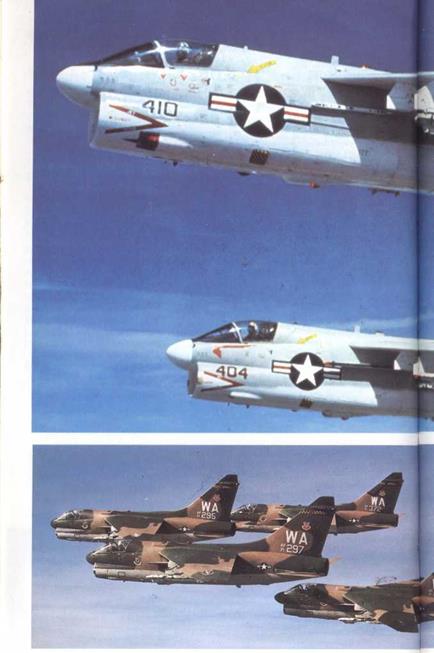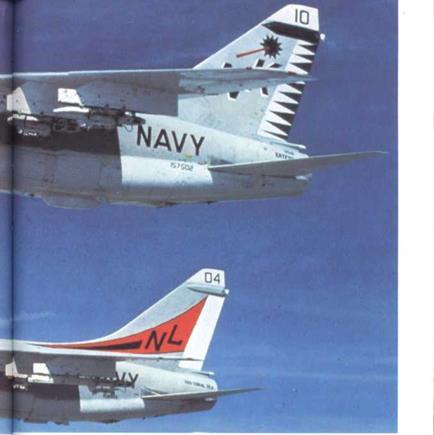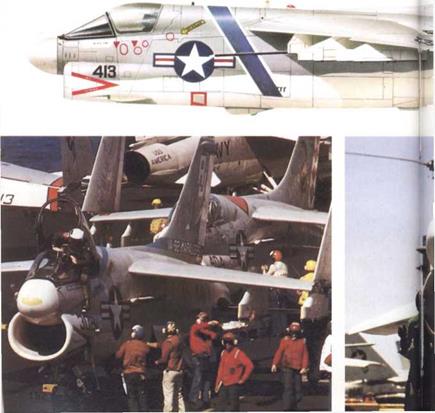Vought A-7 Corsair II
Vought A-7A to К and TA-7C and H
Origin: Vought Systems Division of LTV. Dallas. USA.
Type: Single-seat attack bomber (carrier – or land-based): (ТА) dual trainer.
Engine: (A) one 11,350lb (51 50kg) thrust Pratt & Whitney TF30-6 two – shaft turbofan: (В. C) 12,2001b (5534kg) TF30-8: (D) 14.2501b (6465kg) Allison TF41-1 (Rolls-Royce Spey derivative) of same layout: (E) 15.0001b (6804kg) TF41 -2.
Dimensions: Span 38ft 9in (1T80m): length 46ft 1Jin (14-06m): (ТА) 48ft 2in (14-68m): height 16ft Ofin (4-90m); (ТА) 1 6ft 5in (5m).
Weights: Empty (A) 1 5,904!b (7214kg): (D) 19,781 lb (8972kg): maximum loaded (A) 32,500lb (14,750kg): (D) 42.000lb (19.050kg).
Performance: Maximum speed (all single-seat versions, clean) 698mph (1123km/h) at low level: climb and ceiling, not reported (seldom relevant): tactical radius with weapon load, typically 715 miles (1150km): ferry range with four external tanks, typically 4,100 miles (6600km).
Armament: (A, B) two 20mm Colt Mk 12 in nose: six wing and two fuselage pylons for weapon load of 15,0001b (6804kg). (D, E) one 20mm M61 Vulcan cannon on left side of fuselage with 1,000-round drum: external load up to theoretical 20,000lb (9072kg).
History: First flight 27 September 1965: service delivery October 1966: first flight of D. 26 September 1968.
Users: Greece, Pakistan, USA (Air Force, Navy).
Development: Though derived from the Crusader, the Corsair II is a totally ►
|
|
![]()
Left: An A-7A Corsair II serving during the Vietnam conflict with VA-195 Navy attack squadron embarked aboard USS Kitty Hawk. No longer in service.
Below left: A-7Es of the Carrier Air Group embarked aboard USS America. The A-7E is the most numerous type in Fleet Attack Squadrons.
|

different aircraft. By restricting performance to high subsonic speed, structure weight was reduced, range dramatically increased and weapon load multiplied by about 4. Development was outstandingly quick, as was production. Vought built 1 99 A-7A, used in action in the Gulf of Tonkin on 3 December 1967, followed by 196 В models. The C designation was used for the first 67 E models which retained the TF30 engine. In 1966 the Corsair II was adopted by the US Air Force, the A-7D having the superior TF41 engine, Gatling gun and more complete avionics for blind or automatic weapon delivery under all conditions, with head-up display and inertial/


Above: A-7E Corsair lls from USS Enterprise (nearest camera) and Coral Sea an older carrier now stripped of her wing and replaced in the Atlantic Fleet by Carl Vinson. Today nearly all the E-models are being equipped with pods under the right wing containing a FUR (forward-looking infra-red) with a new Marconi raster/HUD (head-up display) in the cockpit. This is greatly augmenting their capability to attack at night.
Left: By far the greatest number of A-7 Corsair lls are those in service with the US Air Force, nearly all of them being of the A-7D type (the first to have the TF41 engine). These examples were serving with TAC (Tactical Air Command) but most have now been passed on to the Air National Guard. In 1980 Vought began building the new two-seat A-7K combat – capable trainer for ANG units.
doppler navigation. By late 1976 over 480 had been delivered, with reduced production continuing. The Navy adopted the same model, with an even more powerful TF41. and by late 1976 about 540 E models had been built, bringing output to well over 1,400 within a decade. Vought funded development of a tandem-seat YA-7H, and is converting 81 В and C into the dual TA-7C. Greece is receiving 60 A-7H, similar to the D but without the onboard starter or flight-refuelling receptacle, at a price of $259-2 million. Pakistan accepted sale of 110. on condition (it was reported) it did not buy a nuclear reactor offered by France!











